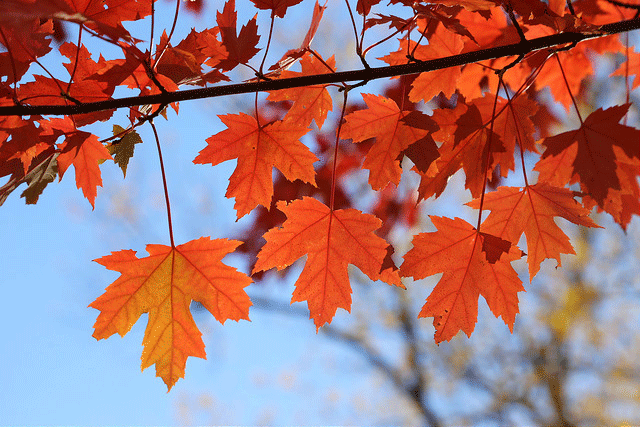Acer floridanum, Florida maple, southern sugar maple, is a small (to 25 feet in the landscape) tree with a single-trunked, rounded habit. This native of the southeastern United States deserves to be used more widely there for its reliable fall color and heat tolerance. Zones 7–9.
Buergerianum, trident maple, can have single or multiple trunks supporting an oval or rounded crown. It normally attains a height of 20 to 25 feet in the landscape but can grow twice as tall. Like many maples, it has three-lobed leaves borne in pairs; the lobes all point in the same direction, away from the base of the leaf. Red or orange fall color may develop in some years. The bark of trident maple is gray and brown, sometimes with orange tones, becoming scaly with age. Zones 6–7.
Ginnala, Amur maple, grows 15 to 20 feet tall in the landscape. While most maples’ flowers are neither fragrant nor showy, Amur maple bears highly fragrant blooms in early spring. The three-lobed leaves have an extended center lobe and may turn scarlet in fall. An introduction from Asia, Amur maple is listed as weedy or invasive in some states but its use is not restricted. Zones 3–7.
Japonicum, full-moon maple, is another small (20 to 30 feet) Asian maple with considerable landscape value. Full-moon maple’s leaves are palmately compound and nearly circular in outline. Flowers are purplish or red. Fall color is crimson and/or yellow in most years and appears more reliably in northern areas. Zones 5–8.
Negundo, box elder, is a northern American native often disdained for its weediness and soft wood, yet it grows in poor soil and difficult sites where many other trees can’t. It has multiple stems, a rounded crown, and a mature height of 50 to 70 feet. Yellow-green flowers appear in early spring before its compound leaves unfold; fall color is a soft yellow. Abundant winged fruits can be messy and lead to numerous seedlings. Zones 2–9.
Palmatum, Japanese maple, normally grows 15 to 20 feet tall; its branches may spread as wide as the tree is tall, creating a layered appearance unlike the more upright form of other maples. The many cultivars offer countless options of twig and leaf color, gnarled or mounded habits, plus lacy threadleaf forms. Protect from direct wind in the North and direct sun in the South. Zones 5–8.
Pensylvanicum is known as moosewood or striped maple. The green chalk-striped bark of this 15- to 20-foot northeastern woodland native has considerable landscape interest. Look for yellow fall color. Striped maple performs best in cool climates under partial shade. Zones 3–6.
Platanoides, Norway maple, is a widely planted street tree with a round, dense crown and tolerance for difficult urban conditions, such as air pollution and poor soil. It grows 40 to 50 feet tall and holds its broadly palmate leaves late into fall. Norway maples cast deep shade, making it difficult to grow turf-grass beneath them. This maple’s abundant, shade-tolerant seedlings allow it to colonize native woodlands, earning it classification as invasive in parts of the Northeast and central United States. Zones 4–6.
Rubrum, red or swamp maple, is a North American native that reaches heights of 40 to 60 feet. Pyramidal in youth, red maple sprawls and arches with age. The smooth gray trunk and branches are distinctive, particularly when trees are grouped. Red flowers open before the leaves and are a softly colorful sign of spring. Fall color is bright red and/or orange. Hardiness and heat tolerance vary within the species; choose a cultivar suited to your location. Zones 3–8.
Saccharinum, silver maple, is touted for its fast growth, but it’s also weedy and weak wooded and may be prone to breakage. Growing 50 to 70 feet high, silver maple is upright, with spreading branches and a rounded crown; its leaves are deeply lobed and silvery beneath. The pale pink flowers appear before the leaves in spring. Look for yellows or reds in fall foliage and a gray, furrowed trunk. Zones 3–8.
Saccharum, sugar, rock, or hard maple, gets its names from the maple sugar derived from its rising spring sap and from the durability of its wood. It has a single trunk and a rounded crown, gray-black furrowed bark, and a mature height of 50 to 70 feet. Sugar maple’s fall color is legendary; in good years the leaves turn gold, orange, and scarlet. Zones 3–7.
How to grow
With the exception of large maples, like red, sugar, silver, and Norway, used as shade trees, most maples benefit from light shade. Generous mulch and a shaded root zone are also advantages. Most maples require acid soils that are evenly moist but well drained, although red maple and box elder occur naturally on swampy sites. Grown in their preferred conditions, maples are relatively problem-free trees. Scorched leaf margins may occur on trees suffering from drought or reflected heat from pavement or cars. Red and silver maples growing in high-pH soil may develop yellowed foliage caused by manganese deficiency. Box elders attract box elder bugs, which like to overwinter indoors. In fall, groups of these black-and-orange insects move into buildings and become household pests.
Landscape uses
Japanese, full-moon, and Amur maples make fine focal points in small-scale settings; larger areas might call for trident maple or sugar maple. Red, striped, and sugar maples are good choices for naturalizing; Norway maple, although tough, is overplanted. Use box elders to supply shade on difficult sites.


